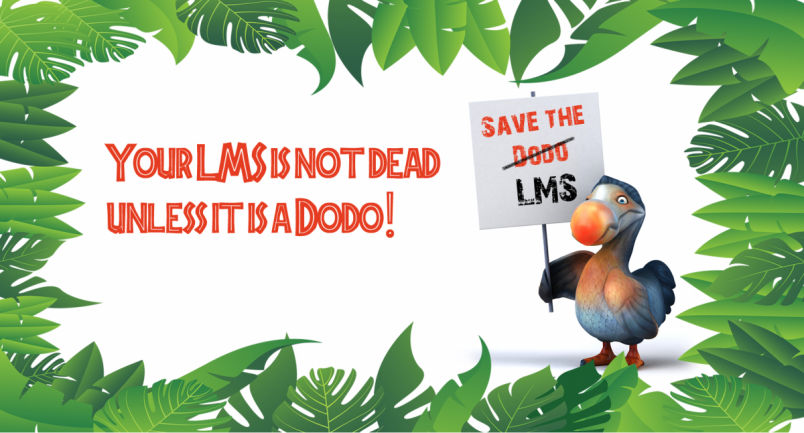The tale of the now-extinct dodo is a sad one. Sadly, not all birds are made equal, and unable to fly, the tasty flightless bird was hunted to extinction. Much like the sad demise of the fateful dodo, not all learning management systems are made equal.
If an LMS fails to evolve with the needs of a business and its learners, it will eventually become threatened. Unable to prove its worth in its natural business habitat, the budgetary predators will circle, and the learning platform’s survival will be under threat. This is usually down to lack of use, poor user engagement, and poor user experience, as well as a lack of business impact or results.
It’s a story I hear all too often when I speak to potential new clients. The frustration I feel for businesses and organisations that have had or experienced a poor LMS is akin to that of a parent’s disappointment at the unfulfilled potential of a child. An LMS that is well implemented, easy to use, strategically planned, aligned with business needs, contains engaging and relevant content, is marketed to user groups, and has the added flexibility for future growth, will, in fact, thrive as a critical business system.
So often organisations over-complicate their LMS. If your system is complicated to manage and maintain, then it will no doubt be complicated for learners to use. Similarly, many will try to run before they can even stand up by implementing a system with all the bells and whistles, along with a tonne of learning, and expecting learners to just get on with it and get it done. That is not the way to do it!
There are lots of things you can do to make your LMS an initial and continued success. This is a rundown of the simple and fundamental building blocks that learning teams should always be keeping at the forefront of everything that they do where their LMS is concerned.

1. If they know about it they will come
Internal marketing is an often overlooked and underused tool in rolling out learning management systems and learning content. An email announcing that something is available and counting on word-of-mouth communication will not be enough to get the message out. You need to start thinking about content or LMS projects as ‘learning campaigns’.
Admittedly, this can mean a bit of trial and error, as what works for one business may not always work as well for another. Think about existing communication channels within the business and how you can make the most of them. Not everyone reads every single email that floats into their inbox, so don’t rely on it. It can also be a good opportunity to create new channels of communication.
Some useful channels outside of emails to consider are:
- Intranets
- Social media groups
- Enterprise Social Networks e.g. Yammer, Totara Social
- Team meetings
- Digital signage, posters and leaflets in or around entrances, reception areas, staff rooms, canteens, notice boards
- Internal roadshows – take your LMS and/or content on a demo tour across different sites
- Computer screensavers and display graphics
If you are relying on email, look at jazzing up the content with some engaging visuals and subject headlines that are going to grab attention.
Developing and implementing an internal marketing campaign might not be suitable for every single piece of new learning, LMS feature(s) or announcement. Be selective about when you decide to go big, especially if you are looking to make an impact. However, having the ability and platform to tap into when needed is a major win.
2. If they can use it and engage with it, they will keep coming back
Have a think about the rising surge in employees looking elsewhere for sources of personal and professional learning. Why is that? It’s easy to do a quick search on Google, look for a how-to on YouTube, check out your Twitter feed for the latest industry news or read an article on your LinkedIn feed. What can we learn from this?
There are two important factors at play here:
- It’s easy! – Simple, quick, accessible and familiar.
- Relevance – Relevant to their needs and available on demand.
If these two factors continually work for you, then you can bet that you will keep returning and using whatever tool it is. If your learners could have the same experience with an LMS there is no doubt that they would use it regularly and keep coming back.
Don’t think of your LMS as a large repository for lots of SCORM courses, and start thinking about your LMS as window dressing where learners can shop around for relevant learning resources.
Think about each of your user groups and the possible journeys they will take when using the system. It can be off-putting when content and resources are buried under layers of screens. Simplify the user journey as much as possible.
Whether you are at the start of your LMS journey or you have been working with, or fighting with, an existing LMS for some time, you should continually ask yourself:
- Is the system easy to use?
- Can learners find and discover content easily?
- Is the content relevant?
If your answer is no or you are not sure, it is time to go back to the drawing board! Once up and running, your LMS requires maintenance and regular reviews. Some of the most successful learning management systems that our customers have implemented, continue to use and develop are the ones where learning teams are continually ensuring that whatever they do with the LMS or put on it is relevant, discoverable, usable and hitting the mark.

3. Get people involved
Whether this is subject matter experts, the IT team, user test groups, key stakeholders, the executive team, line managers… get them involved. In our experience, learning teams can underestimate the reach and impact that an LMS can have. Getting buy-in across the business is unequivocally one of the best things that you can do.
It might not happen straight away, and it might take some convincing – let’s face it, we all know a ‘Dave-the-doubter’! But as time goes on and the more successful your LMS becomes, the more people will want to get involved and want a piece of the action.
Having a good cross-section of opinions is a great temperature check. It will help gain insights into how the system can be used to its best advantage, how you can build in additional functionality, identify where additional support and facilities may be required, as well as gain an understanding of what is and is not working well for moving forward.
No LMS is beyond saving. Taking a step back, having a tidy up of your content, refreshing the look, and or brand of your LMS is a great opportunity to relaunch your LMS and re-engage your audience. I work with customers who continually evolve and re-establish the identity of their LMS within their business or organisation to ensure it is current and meeting the business’ needs.
So, what is the moral of this tale? That’s simple: don’t let your LMS become a dodo!
This is a guest post by MediaCorp’s Sara Kelly


